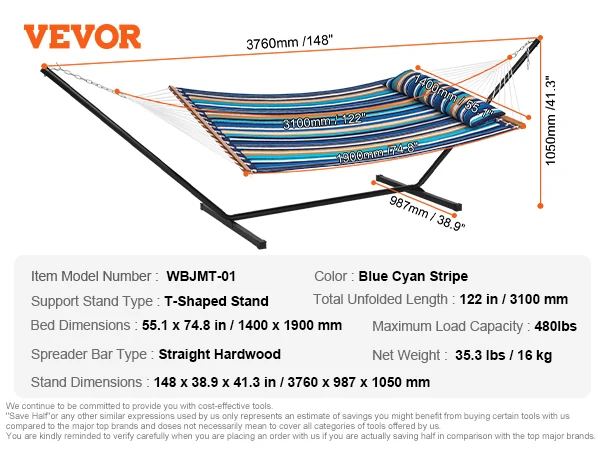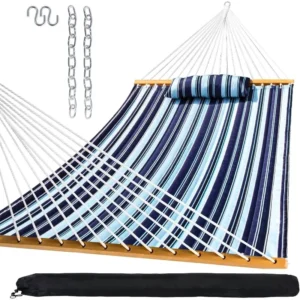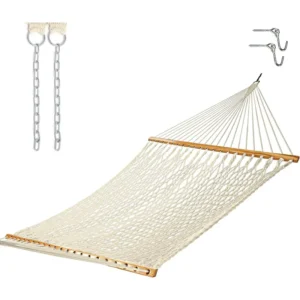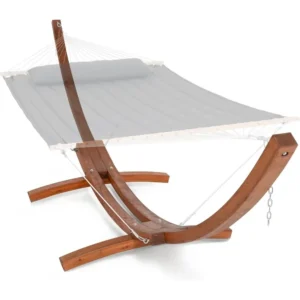Introduction: Why Standard Hammocks Often Fall Short for Larger Body Types
Finding the perfect hammock can be challenging when you’re a person with a larger build. Standard hammocks are typically designed with average-sized users in mind, leaving many heavier individuals frustrated with options that don’t properly support their needs.
Most conventional hammocks come with weight capacities between 250-400 pounds, which doesn’t provide adequate support or safety margin for many people. This limitation isn’t just about the numbers—it affects the entire hammock experience, from comfort to safety to durability.
When hammocks aren’t designed for heavier individuals, several issues can arise:
- Increased risk of fabric tearing or suspension failure
- Uncomfortable sagging that affects back support
- Limited space that restricts movement and relaxation
- Shortened product lifespan due to accelerated wear
This comprehensive guide will help you understand what truly matters when selecting a hammock as a heavier person. We’ll explore weight ratings, essential construction features, optimal dimensions, and specific recommendations to ensure you find a hammock that provides both confidence and relaxation, regardless of your body size.
Understanding proper hammock weight capacity guidelines is the first step toward finding a solution that works for your specific needs.
Why Traditional Hammocks Don’t Meet the Needs of Heavier Individuals
Standard hammocks present several challenges for individuals with larger body types, making them inadequate solutions for heavier users. These limitations extend beyond simple weight capacity numbers and affect the overall experience.
Safety Concerns
The most pressing issue is safety. Traditional hammocks used beyond their intended capacity face significant risks:
- Sudden fabric tears that can cause falls and injuries
- Suspension system failures (straps breaking or anchor points pulling out)
- Hardware failure, including carabiners and hooks that can’t handle dynamic loads
- Accelerated deterioration that may not be visible until complete failure
Comfort Limitations
Even if a standard hammock doesn’t fail outright, comfort issues are common:
– Excessive sagging creates an uncomfortable “banana shape” that strains the back
– Insufficient width causes restrictive “cocooning” that compresses shoulders
– Limited space makes position adjustment difficult or impossible
– Edge tension that creates pressure points and discomfort
Durability Problems
Heavier individuals typically experience dramatically shorter product lifespans with standard hammocks:
– Fabric stretching that permanently deforms the hammock
– Seam stress that leads to progressive failure
– Accelerated wear at suspension points
– Compromised structural integrity that worsens with each use
The peace of mind that comes with using equipment specifically designed for your body type simply cannot be overstated. When you’re relaxing, you should be able to fully unwind without worrying about equipment failure.
For a deeper understanding of what makes hammocks truly supportive, exploring hammock load capacity principles becomes essential for any potential buyer.
Understanding Hammock Weight Ratings: Beyond the Basic Numbers
When shopping for hammocks as a heavier individual, understanding weight ratings becomes crucial for both safety and enjoyment. However, these numbers require proper interpretation beyond their face value.
Static vs. Dynamic Load Ratings
Hammock weight capacities typically reference static loads (when you’re lying still), but dynamic loads (when you sit down, shift position, or swing) can temporarily multiply the force applied:
- Static load: The weight capacity when weight is evenly distributed and stationary
- Dynamic load: The actual force exerted during movement, which can be 1.5-3 times your static weight
This distinction explains why a hammock rated for 400 pounds might still fail when a 300-pound person sits down quickly or shifts position suddenly.
Safety Margins: Why “Just Enough” Isn’t Enough
Smart hammock selection always includes a substantial safety margin:
– Recommended safety buffer: At least 25-30% above your actual weight
– Example calculation: A 280-pound user should look for hammocks rated at 350-375 pounds minimum
– Ideal scenario: Choose the highest capacity you can reasonably afford
This margin accounts for natural product degradation, manufacturing variations, and the dynamic forces created during normal use.
How Manufacturers Determine Weight Limits
Weight capacities are established through:
– Material strength testing under controlled conditions
– Stress testing of seams and connection points
– Evaluation of suspension components individually and as a system
– Application of industry safety factors (typically a calculation that reduces the true breaking point)
The relationship between hammock material and weight capacity directly impacts performance and safety, with material choice often being the most significant factor in determining how much weight a hammock can truly support.
The Essential Components of a Heavy-Duty Hammock
High-Performance Fabrics and Materials
The foundation of any heavy-duty hammock starts with its fabric. Understanding material specifications helps identify truly capable options:
Denier Rating Explained
Denier (D) measures thread thickness—higher numbers mean stronger fabric:
– 70D: Entry-level camping hammocks (lightweight but limited strength)
– 210D: Mid-range strength suitable for moderate use
– 400D+: Heavy-duty fabric ideal for larger individuals
Optimal Fabric Types
– Ripstop Nylon: Features a reinforced weave that prevents tears from spreading; excellent strength-to-weight ratio
– Heavy-duty Polyester: More resistant to UV damage and stretching than nylon; maintains shape better over time
– Canvas: Maximum durability for stationary setups; weather-resistant but heavy
Advanced Construction Methods
– Double-layer designs: Two complete layers of fabric that distribute weight more effectively
– Diamond ripstop patterns: Reinforcement threads in diagonal patterns that significantly enhance tear resistance
– Specialized weaves: Certain weave patterns maximize strength while maintaining comfort
Reinforced Construction Techniques
The way a hammock is put together matters as much as the materials used:
Superior Seam Construction
– Triple-stitched seams: Multiple rows of stitching that provide redundant strength
– Bar-tacking: Concentrated stitching at high-stress points that creates extremely strong reinforcement
– Box-X patterns: Distributes tension across wider areas rather than single stitch lines
Connection Points
– Channel construction: Fabric wrapped around suspension ropes distributes weight better than sewn loops
– Reinforced edge binding: Prevents edge fraying and tears from starting at hammock perimeters
– Layered attachment points: Multiple fabric layers at connection points provide fail-safe strength

Heavy-Duty Suspension Systems
The connection between your hammock and its anchor points represents a critical safety component:
Strap Specifications
– Width matters: 1.5-inch straps distribute force better than 1-inch options
– Optimal length: 9-15 feet per side allows for versatile hanging options
– Material quality: Polyester webbing offers better weather resistance than nylon
Hardware Considerations
– Carabiner materials: Steel carabiners offer significantly higher strength ratings than aluminum
– Gate design: Auto-locking gates prevent accidental opening under load
– Weight ratings: Look for hardware rated at 2-3 times your hammock’s capacity
Rope and Connection Options
– Amsteel and Dyneema: Synthetic options offering incredible strength-to-weight ratios
– Polyester rope: Better UV and water resistance than nylon alternatives
– Connection systems: Continuous loop designs distribute force more evenly than single-point connections
Understanding various hammock support systems with spreader bars and frames can further help select options that provide maximum stability for heavier users.
Optimal Dimensions for Comfort and Support: Size Matters
Finding the right hammock dimensions is particularly crucial for larger individuals, as proper sizing directly impacts weight distribution, comfort, and overall safety.
Length and Width Requirements
A hammock’s size significantly affects its ability to comfortably support heavier users:
- Length needs: Hammocks should be at least 2-3 feet longer than the user’s height. For individuals over 6 feet tall, look for hammocks 10-12 feet in length.
- Width importance: Wider hammocks (6-7 feet) allow for diagonal positioning, which creates a flatter lying position and distributes weight more effectively.
- Size recommendations: Heavier individuals (250+ pounds) benefit most from hammocks at least 10 feet long by 6 feet wide, even when used by a single person.
Double vs. Single Hammocks
The term “double hammock” refers to width, not necessarily capacity for two people:
- Many experienced hammock users recommend “double” or “XL” hammocks for single heavier users
- Wider fabric creates better support by distributing weight across a larger surface area
- Additional material often correlates with stronger construction techniques
Design Considerations
Certain hammock designs offer specific advantages for larger individuals:
- Gathered end vs. spreader bar: Gathered end designs generally offer higher weight capacities, while spreader bar models provide a flatter lay but require stronger construction
- Diagonal positioning: Lying diagonally across the hammock creates a flatter, more bed-like position that reduces pressure points and improves comfort
- Asymmetrical designs: Some hammocks feature specially cut designs that facilitate this diagonal position naturally
Understanding the relationship between single and double hammock weight limits helps clarify why “double” models often provide better solutions for heavier individuals, even when used solo.
Types of Hammocks Suitable for Heavier Individuals
Heavy-Duty Camping & Backpacking Hammocks
These hammocks balance strength with portability for outdoor adventures:
Key Features:
– Specialized lightweight but strong fabrics (often 210D ripstop nylon or higher)
– Compact stuff sacks with compression straps
– Typical weight capacities of 350-500 pounds
– Trail-friendly packed weight (usually under 3 pounds including suspension)
Ideal For:
– Hiking and backpacking where gear must be carried
– Camping trips where setup options may vary
– Users who prioritize versatility across different environments
Limitations:
– May sacrifice some comfort features to reduce weight
– Often require separate purchase of rainfly and bug protection
– Usually more expensive than stationary options due to specialized materials
Sturdy Backyard & Relaxation Hammocks
Focused on maximum comfort and durability for home use:
Key Features:
– Heavy-duty materials like canvas, polyester, or thick cotton
– Often include dedicated stands rated for higher weights
– Typical capacities of 400-800+ pounds
– Built for years of consistent use
Ideal For:
– Permanent or semi-permanent setup in yards or on patios
– Daily relaxation where weight and packed size aren’t concerns
– Maximum comfort prioritization over portability
Limitations:
– Too heavy and bulky for hiking or travel
– Require more space for setup and storage
– Often more expensive than camping options
Specialized Expedition & Asymmetrical Designs
Advanced hammock designs engineered specifically for optimized comfort:
Key Features:
– Asymmetrical cut that creates flatter laying position
– Enhanced weight distribution through specialized geometry
– Often include integrated bug protection and rainfly attachment points
– Multiple tie-out points for customized tensioning
Ideal For:
– Extended overnight use where comfort is paramount
– Side-sleepers who need special accommodation
– Users willing to invest in premium features
Limitations:
– More complex setup than standard hammocks
– Usually the most expensive category
– May require practice to achieve optimal setup
Reinforced Hammock Tents & Integrated Systems
Complete shelter systems built with higher capacities in mind:
Key Features:
– All-in-one designs with hammock, bug net, and rain protection
– Reinforced attachment points for consistent weight support
– Ridge lines that help maintain optimal hang angle
– Modular components that can be used separately or together
Ideal For:
– All-season camping and extended trips
– Environments with unpredictable weather
– Users who want a complete solution in one package
Limitations:
– Heavier than basic hammocks (though often lighter than tents)
– More complex setup procedures
– Higher price point than basic options
Browse our selection of heavy-duty hammock sets specifically engineered to provide reliable support for larger individuals.
Top Recommended Hammocks for Heavier Individuals
When selecting hammocks for heavier individuals, we prioritize verified weight capacity, material quality, construction features, and actual user experiences from larger individuals. Here’s a curated selection of options organized by weight capacity:
Hammocks Rated for 300-400 Pounds
These hammocks offer a good balance between strength and reasonable weight/bulk:
Adventure Explorer XL: Features 210D ripstop nylon construction with triple-stitched seams and reinforced attachment points. At 10’ × 6’, it provides ample space for diagonal positioning while maintaining a reasonable 1.8 lb packed weight. Particularly appreciated for its balanced compromise between durability and packability.
ComfortPro Wilderness: Uses double-layer 70D nylon for enhanced strength without excessive weight. Includes 1.5” tree straps rated for 400 lbs. Users particularly appreciate the spacious dimensions (11’ × 6’) and the included stuff sack with compression straps.
Hammocks Rated for 400-550 Pounds
These mid-range capacity hammocks offer substantial strength for most larger users:
MaxRelax Outdoor: Features heavy-duty 210D nylon with bar-tacked stress points and a unique dual-channel suspension system. At 11’ × 7’, it provides exceptional space for larger frames while maintaining reasonable 2.5 lb packed weight. Particularly suitable for taller individuals up to 6‘6”.
UltraLounge XL: Uses specialty triple-layer construction with a comfort-focused breathable middle layer. Integrated suspension system with aircraft-grade aluminum carabiners completes the package. Users highlight the 12’ length as particularly accommodating for taller individuals.
Hammocks Rated for 550+ Pounds
These maximum-strength options provide confidence for those requiring the highest capacity:
TitanPro Expedition: Utilizes military-grade 400D ripstop fabric with quadruple reinforced seams and a patented weight distribution system. Despite its impressive 800 lb capacity, it maintains a reasonable 3.2 lb packed weight. Users specifically praise the “flat lay” design that virtually eliminates the typical hammock curve.
MegaRest Backyard: Canvas construction with steel spreader bars creates an exceptionally sturdy platform rated for 700+ lbs. While not portable (15 lbs total weight), it provides unmatched stability for stationary use and includes a dedicated stand.
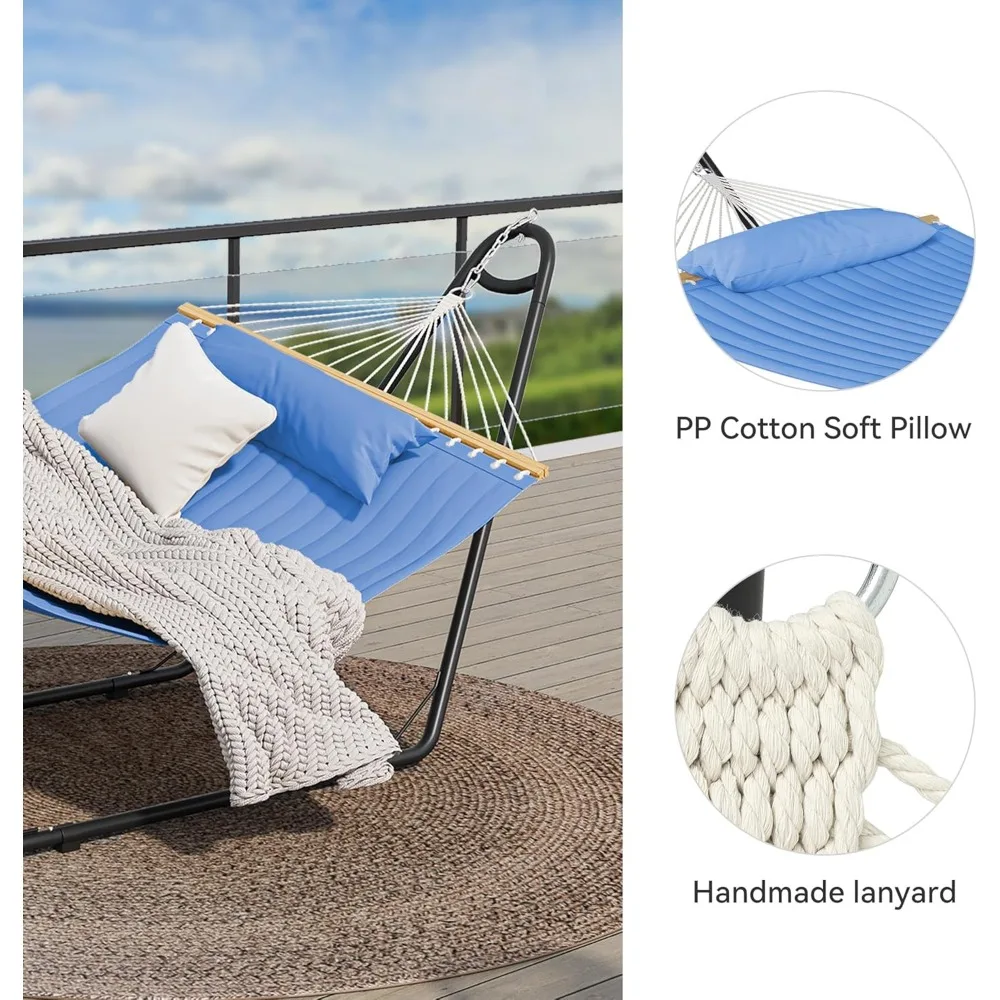
Integrated Hammock and Stand Combinations
These complete systems eliminate the need to find suitable hanging points:
TotalSupport System: Steel frame construction with reinforced connection points supports up to 600 lbs. The included polyester hammock features spreader bars for a flat lay, and the entire system breaks down for transportation in the included carrying case.
UltraStand Complete: Powder-coated steel frame with enlarged base provides exceptional stability for users up to 550 lbs. Quick-assembly design requires no tools, and the weather-resistant materials make it suitable for permanent outdoor placement.
| Hammock Model | Weight Capacity | Dimensions (L × W) | Material | Suspension Included | Price Range | Key Feature for Heavier Users |
|---|---|---|---|---|---|---|
| Adventure Explorer XL | 400 lbs (181 kg) | 10’ × 6.5’ (305 × 198 cm) | 210D Ripstop Nylon | Yes – 1.5” Straps | $$ | Triple-reinforced stitching |
| ComfortPro Wilderness | 400 lbs (181 kg) | 11’ × 6’ (335 × 183 cm) | Double-layer 70D | Yes – Carabiners only | $$ | Double-layer construction |
| MaxRelax Outdoor | 450 lbs (204 kg) | 11’ × 7’ (335 × 213 cm) | 210D Ripstop Nylon | Complete system | $$ | Dual-channel suspension |
| UltraLounge XL | 500 lbs (227 kg) | 12’ × 6.5’ (366 × 198 cm) | Triple-layer design | Yes – Premium system | $$$ | Breathable comfort layer |
| TitanPro Expedition | 800 lbs (363 kg) | 12’ × 8’ (366 × 244 cm) | 400D Military-grade | Complete system | $$$ | Flat lay design technology |
| MegaRest Backyard | 700 lbs (318 kg) | 13’ × 5’ (396 × 152 cm) | Canvas/Steel | Integrated stand | $$$ | Spreader bar stability |
| TotalSupport System | 600 lbs (272 kg) | 12’ × 5’ (366 × 152 cm) | Polyester/Steel | Integrated stand | $$$ | Tool-free assembly |
| UltraStand Complete | 550 lbs (249 kg) | 15’ × 5’ (457 × 152 cm) | Weather-resistant fabric | Integrated stand | $$$ | Extended base stability |
Explore our selection of double hammock sets that provide extra width and capacity for enhanced comfort.
Selecting a Heavy-Duty Hammock Stand: Critical Support Considerations
A hammock stand deserves just as much consideration as the hammock itself, particularly for heavier individuals. The wrong stand can compromise safety and stability regardless of how strong your hammock might be.
Materials and Design Considerations
Different stand materials offer varying benefits for higher weight capacities:
- Steel tube frames: Provide maximum strength with capacities often exceeding 500 pounds; look for powder-coated finishes to prevent rust and 12-16 gauge steel thickness
- Wooden arc designs: Offer natural aesthetics with excellent strength when properly constructed; cypress and teak provide natural weather resistance
- Portable systems: Typically feature aluminum construction; verify specific weight capacities as these vary widely (200-500+ pounds)
Critical Evaluation Factors
When selecting a stand, these factors determine true performance:
- Verified capacity: Always check manufacturer specifications for maximum weight ratings
- Base width: Wider bases provide greater stability; look for bases at least 4-5 feet wide for maximum stability
- Connection points: Heavy-duty hooks or chains should match or exceed the hammock’s capacity rating
- Material thickness: For metal stands, thicker gauges (lower numbers) indicate stronger materials
- Assembly quality: Welded joints typically offer greater strength than bolted connections
Compatibility Considerations
Not all stands work with all hammocks:
- Length compatibility: Ensure your stand accommodates your hammock’s full length
- Hanging height: Adjustable stands allow customization for comfort and proper weight distribution
- Attachment style: Confirm your hammock’s end design (spreader bars vs. gathered ends) works with the stand
For serious weight support, A-frame stand hammock sets often provide the most stable foundation with the highest capacity ratings.
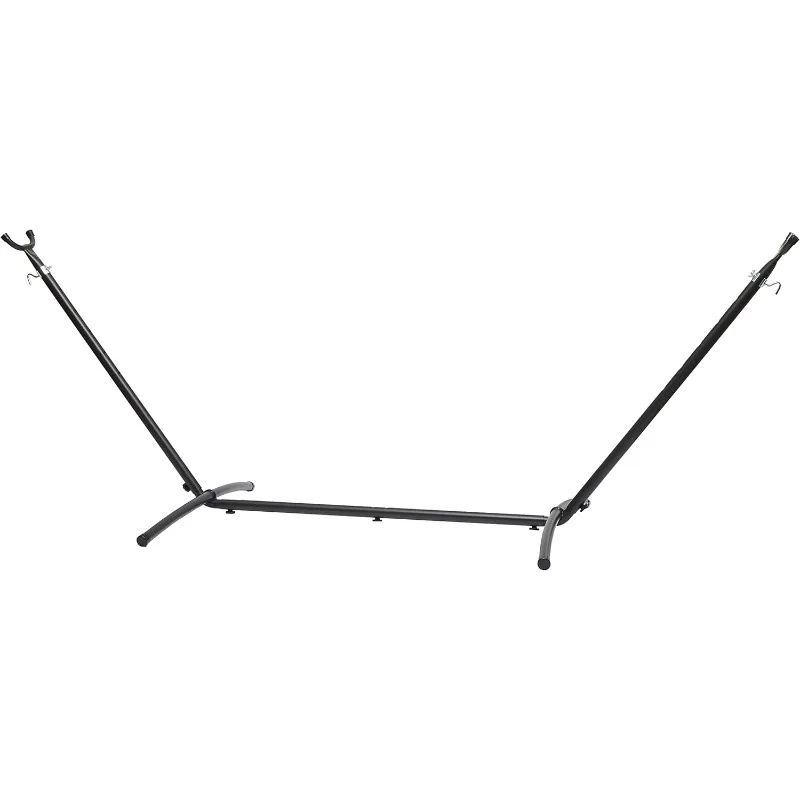
Safety and Longevity: Essential Practices for Heavy-Duty Hammock Users
Proper Hanging Techniques for Maximum Support
Following proper setup procedures significantly enhances both safety and comfort:
Anchor Point Selection
– For trees, select trunks at least 8 inches (20cm) in diameter
– For posts or structural elements, verify load capacity exceeds your hammock’s rating
– Avoid dead trees, damaged structures, or anything showing signs of weakness
Achieving Proper Hang Angle
– Aim for approximately 30 degrees from horizontal for optimal weight distribution
– Too tight (flat) increases stress on the hammock and suspension
– Too loose (significant sag) creates uncomfortable pressure points and reduces capacity
Testing Protocol
1. Install hammock at proper height and tension
2. Test by gradually applying weight, listening for any unusual sounds
3. Sit in center first, then carefully shift to full laying position
4. Re-check all connection points after initial loading
Understanding Weight Limit Safety Margins
Weight limits aren’t just suggestions—they’re critical safety guidelines:
- Standard industry safety factors already account for some margin of error
- Exceeding stated capacity dramatically increases failure risk
- Dynamic movements (sitting quickly, bouncing) can temporarily double or triple applied force
- Environmental factors (rain, UV exposure) progressively reduce effective capacity
Warning Signs of Approaching Limits
– Unusual creaking or popping sounds
– Visible stretching or deformation of fabric
– Seam separation or thread exposure
– Excessive sagging beyond normal expected hang
Inspection and Maintenance Routines
Regular maintenance significantly extends hammock life:
Visual Inspection Checklist
– Check stitching for separation or loose threads
– Examine fabric for thinning, stretching, or abrasion damage
– Inspect connection points for deformation or wear
– Look for UV damage (color fading, brittleness)
– Verify suspension components for wear or corrosion
Cleaning and Care
– Follow manufacturer’s specific instructions
– Generally, hand wash with mild soap and cool water
– Always allow to dry completely before storage
– Avoid harsh chemicals that can degrade fibers
– Consider UV protectant sprays for hammocks with frequent sun exposure
Storage Best Practices
– Store loosely rather than tightly compressed when not in use
– Keep in dry, cool environment away from direct sunlight
– Avoid prolonged storage while damp or dirty
– Consider a breathable storage bag rather than plastic
Understanding how much weight a hammock can truly hold in real-world conditions helps inform better maintenance practices and safety awareness.
Frequently Asked Questions About Hammocks for Heavier Individuals
Do ‘double’ hammocks actually work better for heavier single users?
Yes, in most cases. Double hammocks typically offer wider dimensions and stronger construction, providing better weight distribution and comfort for larger individuals. The extra fabric allows for diagonal positioning, which creates a flatter, more comfortable lay while reducing pressure points. Most experienced hammock users recommend double hammocks for anyone over 200 pounds, even when used by a single person.
What are the warning signs that my hammock is reaching its weight limit?
Key warning signs include unusual stretching or sagging, creaking or popping sounds during use, visible stress on seams or connection points, and fabric deformation that doesn’t recover when unloaded. If you notice threads beginning to separate at seams or attachment points, this indicates you’re approaching or exceeding safe capacity. Never ignore these warning signs, as they often precede complete failure.
Are heavy-duty hammocks significantly bulkier or heavier for backpacking?
There is typically some weight penalty, but it’s often less significant than expected. Modern heavy-duty hammocks using advanced materials may weigh only 20-40% more than standard versions while offering up to double the weight capacity. For example, a standard backpacking hammock might weigh 1.2 pounds while a reinforced version with 450+ pound capacity might weigh 1.7 pounds—a worthwhile trade-off for safety and durability.
How do weight capacities differ between hammock stands and the hammocks themselves?
Stands and hammocks often have different weight ratings, and your setup is only as strong as its weakest component. Hammock stands typically have more precisely engineered weight limits due to their rigid construction, while hammocks may have more built-in safety margin. Always verify both ratings and use the lower of the two as your guideline. Some stands rated for 450 pounds may actually pair with hammocks rated for 500+ pounds.
Can I substitute chains or rope for the recommended tree straps with heavy-duty hammocks?
This is not recommended. While chains or rope might seem stronger, they often create concentrated pressure points that damage trees and can actually reduce overall system strength. Wide webbing straps (1-1.5 inches) distribute weight more effectively and safely. If strength is a concern, look for specialized heavy-duty hammock straps rated for 1000+ pounds rather than improvising with alternatives.
What’s the best way to get in and out of a hammock as a heavier person?
The safest entry technique is to:
1. Sit in the center of the hammock as you would on a chair, with the fabric gathered slightly beneath you
2. Keep your weight centered while gradually swinging your legs up into the hammock
3. Use a hand on each side for stability during the process
For exit, reverse the procedure, keeping your weight centered until your feet are firmly on the ground. Avoid entering or exiting from the ends or sides of the hammock, as this creates uneven tension and increases failure risk.
A-Frame Stand Hammock Sets, Swinging Hammock Chair Sets
$154.62 Select options This product has multiple variants. The options may be chosen on the product pageClassic Wooden Stand Hammock Sets, Heavy Duty Hammock Sets
$1,061.68 Select options This product has multiple variants. The options may be chosen on the product pageHammock Sets with Canopy, Heavy Duty Hammock Sets
$286.31 Select options This product has multiple variants. The options may be chosen on the product pageDouble / Two Person Hammock Sets, Rope Hammock Sets
Double Traditional Cotton Rope Hammock with Extension Chains – 450 lbs Capacity for Backyard & Patio$292.98 Select options This product has multiple variants. The options may be chosen on the product pageHeavy Duty Hammock Sets, Wooden Arc Stand Hammock Sets
$878.66 Select options This product has multiple variants. The options may be chosen on the product page
Our spreader bar hammock sets provide enhanced stability and weight distribution, making them excellent options for users seeking maximum support.
Investing in Your Comfort: Finding the Perfect Heavy-Duty Hammock
Finding the right hammock as a heavier individual isn’t just about purchasing a product—it’s about investing in countless hours of comfortable relaxation and outdoor enjoyment. The perfect hammock becomes an essential companion for everything from backyard afternoons to wilderness adventures.
When selecting your hammock, remember the critical factors that truly matter:
– Verified weight capacity with a 25-30% safety margin above your needs
– Quality materials (high denier ratings, ripstop construction, and reinforced stitching)
– Appropriate dimensions for your height and build
– A suspension system that matches or exceeds your hammock’s strength
– Proper setup and maintenance practices that maximize safety and longevity
The good news is that today’s market offers more high-quality options for heavier individuals than ever before. Manufacturers are increasingly recognizing the importance of inclusive design that accommodates all body types without compromising on safety or comfort.
By investing in a properly rated, well-constructed hammock, you’re not just purchasing a product—you’re securing peace of mind and the freedom to fully relax. Remember that quality outdoor equipment is an investment that pays dividends in comfort, safety, and enjoyment for years to come.
Outside Luxe is committed to helping every customer find the perfect hammock solution, regardless of body size or specific needs. Browse our complete collection of hammock and stand combinations to find your ideal match for years of comfortable relaxation.

